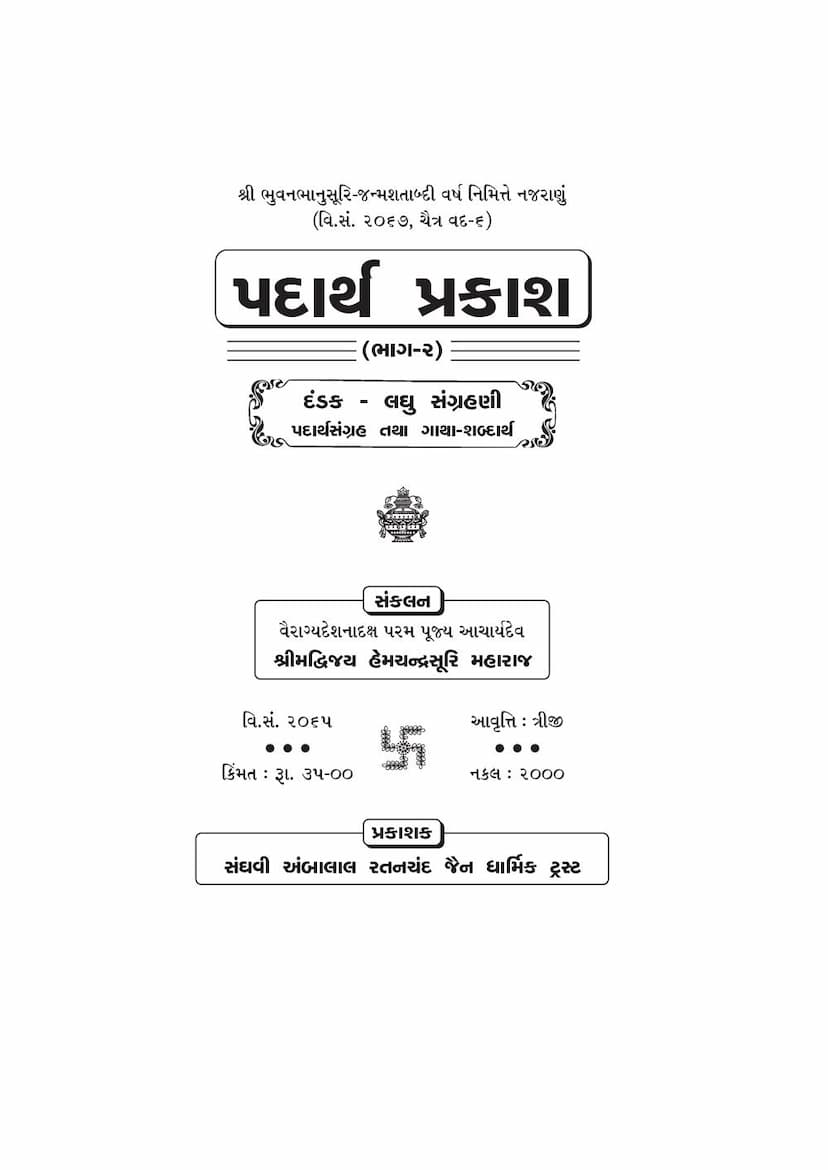Padartha Prakasha Part 02
Added to library: September 2, 2025

Summary
Here's a comprehensive summary of the provided Jain text, "Padartha Prakasha Part 02," authored by Acharya Hemchandrasuri:
Book Title: Padartha Prakasha Part 02 Author: Acharya Hemchandrasuri Publisher: Sanghavi Ambalal Ratanchand Jain Dharmik Trust
Overall Purpose:
This book, "Padartha Prakasha Part 02," is part of a larger series aimed at clarifying the profound principles and concepts of Jainism for the lay community. The author, Acharya Hemchandrasuri, compiled and organized these explanations to make complex philosophical and cosmological topics easily understandable for the Jain Sangha (community). The goal is to foster greater understanding and practice of Jain teachings.
Content Summary:
This particular volume, Part 02, focuses on two key Jain texts:
-
Dandaka (દંડક): This section deals with the "Dandaka" chapters, which categorize living beings based on various characteristics. The text explains the classification of souls into different "dandakas" (groups or categories) and then delves into 24 specific "dwaras" (doors or aspects) related to these beings. These aspects include:
- Body (શરીર): Describing the five types of bodies (Audārika, Vaikriya, Āhārak, Taijasa, Kārmana).
- Height/Dimension (અવગાહના): Discussing the spatial measurement of bodies.
- Bone Structure (સંઘયણ): Explaining the six types of skeletal formations.
- Consciousness/Instincts (સંજ્ઞા): Detailing four or ten types of instincts like food, fear, sex, and possession.
- Posture/Form (સંસ્થાન): Describing the six types of bodily forms.
- Passions (કષાય): Outlining the four primary passions: anger, pride, deceit, and greed.
- Aura/Glow (લેશ્યા): Explaining the six types of auras (Kṛṣṇa, Nīla, Kāpota, Tejas, Padma, Śukla) that reflect the soul's spiritual state.
- Sensory Organs (ઈન્દ્રિય): Discussing the five sensory organs.
- Expulsion of Soul Particles (સમુદ્યાત): Detailing seven types of expulsion of soul particles for various purposes.
- Viewpoint/Belief (દૃષ્ટિ): Categorizing beings into right-believers (samyakdṛṣṭi), mixed-believers (miśra-dṛṣṭi), and wrong-believers (mithyādṛṣṭi).
- Perception (દર્શન): Explaining the four types of perception (Chakṣu, Achakṣu, Avadhi, Kevala).
- Knowledge (જ્ઞાન): Describing the five types of knowledge (Mati, Śruta, Avadhi, Manahparyaya, Kevala) and three types of ignorance (Ajñāna).
- Karma-Yoga (યોગ): Enumerating the fifteen types of yoga (mind, speech, and body actions).
- Usage/Application (ઉપયોગ): Listing the twelve types of usage related to knowledge and perception.
- Rebirth Occurrence (ઉપપાત): Discussing the timing and number of rebirths.
- Cessation of Existence (ચ્યવન): The process of leaving one life and moving to another.
- Lifespan (સ્થિતિ): The duration of life for different beings.
- Accomplishment/Development (પર્યાપ્તિ): The stages of development for different beings.
- Consumption of Matter (કિમાહાર): The process of consuming matter for sustenance.
- Sentience (સંજ્ઞી): Differentiating between sentient and non-sentient beings.
- Migration/Movement (ગતિ): The direction of soul movement after death.
- Arrival/Origin (આગતિ): The origin from which souls come.
- Feeling/Sensation (વેદ): Discussing the three types of feelings (male, female, neuter).
- Relative Strength (અલ્પબહુત્વ): Comparing the numbers of beings in different categories.
-
Laghu Sangrahaṇī (લઘુ સંગ્રહણી): This section focuses on the "Laghu Sangrahaṇī," specifically the "Jambūdvīpa Sangrahaṇī." This text describes the structure and geography of Jambūdvīpa, the central continent in Jain cosmology. It details:
- Ten Aspects (દશ દ્વાર): The text systematically covers ten key aspects related to Jambūdvīpa's structure:
- Divisions/Continents (ખંડ): Describing the 190 divisions of Jambūdvīpa.
- Measurement/Yojanas (યોજન): Explaining the dimensions and calculations of Jambūdvīpa's area.
- Regions/Lands (ક્ષેત્ર): Identifying the seven major regions (Bharata, Himavanta, Harivarṣa, Mahāvideha, Ramya, Hiraṇyavanta, Airāvata).
- Mountains (પર્વત): Listing and describing the various mountains, including the six major "Varṣadhara" mountains, Mount Meru, four "Vakṣaskara" mountains, and others.
- Peaks (કૂટ): Detailing the numerous peaks on these mountains.
- Holy Sites (તીર્થ): Identifying significant pilgrimage sites.
- Ranges (શ્રેણિ): Describing the settlements or ranges of Vidyādhara (celestial beings) and Ābhiyogika Devas.
- Territories/Viharas (વિજય): Enumerating the 34 major territories within Jambūdvīpa.
- Lakes/Ponds (દ્રહ): Describing the sacred lakes.
- Rivers (નદી): Explaining the numerous rivers that flow through Jambūdvīpa.
- Illustrations: The text includes diagrams (Chitra Nos. 1-10) to visually represent the geographical layout of Jambūdvīpa, Mount Meru, and other features, making the descriptions more accessible.
- Eternal Shrines (શાશ્વત ચૈત્યો): The appendices also discuss the concept of eternal shrines and idols that exist throughout the cosmos, providing their locations and counts across different realms within Jain cosmology.
- Methods for Accumulating Merit (પુણ્ય પુષ્ટ કરવાના દશ ઉપાયો): A list of ten practices to enhance spiritual merit is also included.
- Ten Aspects (દશ દ્વાર): The text systematically covers ten key aspects related to Jambūdvīpa's structure:
Author's Inspiration and Dedication:
The book is dedicated to Shri Bhuvan Bhanu Suri, celebrating his birth centenary. The compiler, Acharya Hemchandrasuri, acknowledges the profound influence and guidance of his spiritual predecessors, particularly Acharya Shrimad Vijay Premsurishwarji Maharaj and Acharya Shrimad Vijay Bhuvan Bhanusurishwarji Maharaj, and Panyas Shripad Vijayji Ganivarayji, from whom he received this knowledge.
Biographical Note:
The initial pages also contain a biographical tribute to Muliben, the mother of the trust's founder, highlighting her virtuous life characterized by devotion, tolerance, and extensive charitable activities, particularly in establishing the "Sanghavi Ambalal Ratanchand Jain Dharmik Trust" and its many philanthropic endeavors.
Target Audience and Significance:
"Padartha Prakasha Part 02" is intended for students and followers of Jainism seeking a deeper understanding of core philosophical and cosmological teachings. By breaking down complex subjects into digestible parts and using clear explanations, the book aims to illuminate the path of spiritual progress according to Jain principles. The inclusion of verses with their meanings (Gatha-Shabdarth) further aids in comprehension.